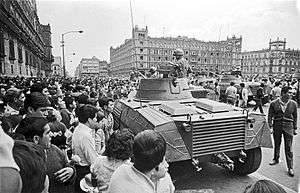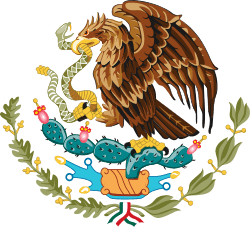Mexican Movement of 1968
| Mexican Movement of 1968 | |
|---|---|
| Part of the Protests of 1968 | |
 Armored cars at the "Zócalo" in Mexico City in 1968 | |
| Date | 1968 |
| Location | Mexico |
| Caused by | |
| Goals | Democratic changes, civil liberties |
| Methods | Student strike, demonstrations, assemblies, social organization |
| Resulted in | Tlatelolco massacre, start of the Dirty War |
Part of a series on the |
|---|
| History of Mexico |
 |
|
Spanish rule |
| Timeline |
|
|
The Mexican Movement of 1968, the Mexican Student Movement or the Student Movement (in Spanish, Movimiento Estudiantil) was a social movement[1] conducted by students from National Autonomous University of Mexico, National Polytechnic Institute, El Colegio de México, Chapingo Autonomous University, Ibero-American University, Universidad La Salle and Meritorious Autonomous University of Puebla[2], among others grouped in the National Strike Council; and supported by the Mexican civil society as workers, farmers, housewives, merchants, intellectuals, artists and teachers[3][4]. The movement had a list of claims to the President and Government of Mexico for specific student specific actions such as the release of political prisoners and the reduction or elimination of authoritarianism. In the background, the movement was motivated by the global Protests of 1968[5] and struggled for a democratic change in the country, more political and civil liberties, the reduction of inequality and the resignation of the government of the ruling Institutional Revolutionary Party (PRI) that they considered authoritarian[1].
The movement aroused from July–October 1968 in the context of the buildup to the 1968 Summer Olympics in Mexico City and the worldwide protests that year.[6][7] In the course of the movement was permanently repressed by the government and finally tried to annihilate on the Tlatelolco massacre on October 2, 1968. The massacre was planned and executed under the code name Operation Galeana, by the paramilitary group called Olimpia Battalion, the Federal Security Direction (DFS), then the so-called Secret Police and the Mexican Army simulating a shooting in the Plaza de las Tres Culturas after the conclusion of a concentration of the CNH. One year after, in 1969, president Gustavo Díaz Ordaz –also a CIA's informer assumed the responsibility of the massacre.
Twenty two years after the Government of Mexico created a Special Prosecutor for the Social and Political Movements of the Past (FEMOSSP, in Spanish) which published several conclusions in an Historical Inform to the Society[1] after the reopening of the case and concluded that the movement marked an inflection "in the political times of Mexico", and was "independent, rebellious and close to the civil resistance" this last recognized officially as false the main argument of the Diaz Ordaz's official version that the reason behind the movement was the pretension of the installation of a Communist regime[1]. With this argument the mexican government justified a strategy to combat the movement and characterizing it as a foreign risk with terrorists pretensions[1].
In that order the Mexican Government planned and ordered an extermination campaign during the months of the movement and after based on a massive strategy of Human Rights violations as false imprisonments, abuses, torture, persecution, espionage, criminalization; also crimes as forced disappearances, homicides and extrajudicial killings[1][8]. All along this period the Mexican Government had an active advising, presence and intelligence operations of the Central Intelligence Agency of the United States[1] under the undercovered Operation LITEMPO including having Diaz Ordaz and other high representatives of the Mexican Government as informants[9][10]. The number of victims, disappeared and imprisoned is still imprecise[1].
Some victims of the Tlatelolco massacre tried to sue the October 2 killings on national and international courts as a crime against humanity and a genocide, affirmation that was sustained by FEMOSPP but rejected by its courts. Some political scientists, historians and intellectuals like Carlos Monsiváis[11] agreed in pointing out that this movement and its conclusion incited a permanent and more active critical and oppositional attitude of civil society, mainly in public universities. As well provoked the radicalization of some survivor activists who opted for clandestinity and formed urban and rural guerrillas, which were repressed in the so-called Dirty War on the 70s.
Origins
For several years prior to the protests, Mexico had experienced a period of strong economic performance called the Mexican miracle. The government wanted to showcase this progress to the world during the Olympics. However, the economic growth hadn't been spread evenly, and students saw an opportunity to bring reforms and more democracy to Mexico.[7][12] Arising from reaction to the government's violent repression of fights between rival porros (gangs), the student movement in Mexico City quickly grew to include large segments of the student body who were dissatisfied with the regime of the PRI.[13]
The 1968 Olympic Games took place in Mexico, making it the first developing country to host this event. This represented an important source of income to the country because of the tourists who would come to attend the Olympics. Giving a good impression to the world could lead to the introduction of international investors. However the students were against these ideals. They did not believe that the appearance of Mexico to the world was a priority. They preferred a revolution resulting in the reformation of their country. "No queremos Olimpiadas, queremos revolución" (We do not want Olympic Games, we want a revolution).[14] The IOC threatened to move the Games to Los Angeles if the situation deteriorated.[15][14]
Protests
Protests took place throughout 1968, and were often violently stopped by police.[7]
Silence March
The Silence March was a silent demonstration that took place on September 13, meant to prove that the movement was not a series of riots but had discipline and self-control.[16]
Tlatelolco massacre
From July to September 1968, student movements started to arise and become stronger, to the point that the government began aggressively intervening. On October 2, 1968, at 5 PM in the Plaza de las Tres Culturas in Tlatelolco, a neighborhood of Mexico City, almost 10 thousand men, women and children stood waiting for a meeting to start. However, when the leaders of the several student organizations and movements arrived, policemen and the military, sent by president Díaz Ordaz and commanded by Luis Echeverria, decided to dissolve the meeting. A student claims that at about 6:10 a helicopter dropped three flares over the plaza, quickly followed by the first gunshots. Students were kidnapped, tortured, and terrorized by the government. [17][18]
Aftermath
This social movement brought unavoidable consequences which permanently changed the future of Mexico,[15] but these political and social changes were not immediate, the repression continued with the Corpus Christi massacre in 1971.
The major change caused by this movement came at a political level. The citizens had the opportunity to live a new democracy in which their opinion could actually bring change in society. People no longer trusted completely in the government and would no longer live completely under the conscious control of their government, nor tolerate it anymore,[17] although they were not completely free. Octavio Paz resigned from the Indian embassy as an act of protest against the government's harsh repression of the student movements. However, there were also some older intellectuals who were in favor of the government, like Agustín Yañez.[14]
References
- 1 2 3 4 5 6 7 8 Informe Histórico presentado a la sociedad mexicana: Fiscalía especial FEMOSPP. Serie: México: Genocidio y delitos de lesa humanidad. Documentos fundamentales 1968-2008. (Historical Report presented to the Mexican society: Special Prosecutor's Office FEMOSPP. Series: Mexico: Genocide and crimes against humanity. Key documents 1968-2008). Mexico: Attorney General of Mexico-Comité 68. 2008.
- ↑ Agüera Ibáñez, Enrique; Benemérita Universidad Autónoma de Puebla; Dirección General de Fomento Editorial; Benemérita Universidad Autónoma de Puebla; Programa de Estudios Universitarios Comparados (2008). El 68 en Puebla: memoria y encuentros (in Spanish). Puebla, México: Benemérita Univ. Autónoma de Puebla. ISBN 9789688637265.
- ↑ Monsiváis, Carlos (2010). Días de guardar (in Spanish). México: Ed. Era. ISBN 9786074450392.
- ↑ Poniatowska, Elena (2015). La noche de Tlatelolco: testimonios de historia oral (in Spanish). ISBN 9788416020355.
- ↑ Wallerstein, Emmanuel (1989). "1968: revolución en el sistema-mundo. Tesis e interrogantes". Estudios Sociológicos. 7 (20): 229–249.
- ↑ "Mexico's 1968 Massacre: What Really Happened?". NPR.
- 1 2 3 Trufelman, Avery (28 June 2017). "Mexico 68". 99% Invisible. Retrieved 14 July 2017.
- ↑ Aguayo, Sergio (1999). 1968: los archivos de la violencia (1968: the violence files) (in Spanish). Mexico: Grijalbo : Reforma. ISBN 9700510263.
- ↑ Jefferson, Morley (2006-10-18). "LITEMPO: Los ojos de la CIA en Tlatelolco (Litempo: the CIA's eyes on Tlatelolco)". National Security Archive.
- ↑ Morley, Jefferson (2011). Nuestro hombre en México: Winston Scott y la historia oculta de la CIA (in Spanish). Santillana USA Publishing Company Incorporated. ISBN 9786071108883.
- ↑ Monsiváis, Carlos (2008). El 68: la tradición de la resistencia (The 68: the resistance traditon) (in Spanish). México, D.F.: Ediciones Era. ISBN 6074450013.
- ↑ "Mexican students protest for greater democracy, 1968". Global Nonviolent Action Database.
- ↑ ""La democracia, punto de unión universal entre quienes animamos ese movimiento, se vuelve un espejismo cuando nos acercamos tratando de precisar su contenido." See Sergio Zermeño, México, una democracia utópica: El movimiento estudiantil del 68, 5th Edition (Mexico City: Siglo Veitiuno, 1985), 1.
- 1 2 3 Ponitowska, Elena (September 1998). "Son cuerpos, señor…". Equis. pp. 3–8.
- 1 2 Xypolia, Ilia (2013). Gokay, Bulent; Xypolia, Ilia, eds. "Turmoils and Economic Miracles: Turkey '13 and Mexico '68" (PDF). Keele, UK: Keele European Research Centre. p. 33.
- ↑ Poniatowska, Elena. Massacre in Mexico, trans. Helen R. Lane Columbia: University of Missouri Press, 1991.
- 1 2 González, Víctor M. (June 2003). "México 1968…¡No se olvida!". Instituto Tecnológico y de Estudios Superiores de Occidente. Archived from the original on November 3, 2007. Retrieved 2007-11-07.
- ↑ Youtube footage in which flare drop is visible. Footage was recorded secretly by the government on the day of the massacre. See: Radiodiaries.org
- Pérez, Javier; H. Magaña (February 2003). "Los Movimientos Estudiantiles en México". FES Zaragoza-UNAM. Retrieved 2007-11-07.
